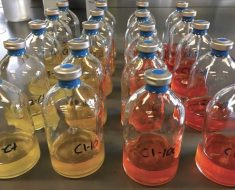Small-angle X-ray scattering (SAXS) is an analytical technique used to identify differences in density within a sample with nanoscale resolution. It works by analyzing the elastic scattering angles of X-rays.
-1.jpg) molekuul_be | Shutterstock
molekuul_be | Shutterstock
SAXS can determine the nanoscale structure of solids, liquids and gaseous particulate matter of almost any material, including biomacromolecules, such as proteins and nucleic acids. This method is non-destructive and requires very little sample preparation.
Why use SAXS to analyze proteins?
Determining the oligomeric states and quaternary structures of proteins
SAXS is an excellent tool for determining the oligomeric states and quaternary structures of proteins in solution by comparing with theoretical structures. The average molecular mass of proteins can also be determined without using protein standards.
SAXS is a relatively low-resolution technique compared to X-ray crystallography, and thus is more suited to determine the quaternary structure of proteins as opposed to earlier levels of protein structure such as tertiary folding. X-ray crystallography requires crystallization, leading to the formation of protein-protein complexes that may not accurately reflect physiological conditions.
Finally, SAXS analysis takes only minutes to several days to perform, while X-ray crystallography may take weeks or even years to develop sufficient information.
Determining atomic level information
NMR is a powerful complimentary technique to SAXS to determine atomic level information regarding macromolecules of over 40 kDa, while SAXS is applicable to both smaller and larger molecules. Other complimentary techniques include size exclusion chromatography to separate heterogeneous samples.
SAXS can be performed in almost any buffer, as long as the composition of the buffer is known. Additionally, SAXS can provide information regarding flexible regions of the protein structure, which is difficult for most other analytical techniques.
How does SAXS Gather Information on Proteins?
Monochromatic X-ray beam is used to illuminate the protein sample, and most of the photons pass through without interaction. Some of the emitted photons interact with electrons surrounding atoms belonging to the protein, causing them to scatter elastically (without loss of kinetic energy). The angle of scattering is in the range of 0.1–1 and is greater when interacting with an area of higher electron density.
An X-ray detector located behind the sample and perpendicular to the beam of incident X-rays, then obtains a scattering pattern that can be used to determine volume, structure, surface area, composition and aggregation behaviour of the protein. SAXS is not suitable to determine atomic structure.
Limitations of SAXS
Protein aggregation and degradation leads to incorrect structural predictions in SAXS as aggregated proteins possessing far higher electron density, and scatter the X-ray photons more strongly leading to overestimation of particle size. Degradation has the opposite effect.
The averaging nature of SAXS data also means that sample homogeneity is paramount to achieve reliable data, thus separation techniques and methods of checking monodispersity must be employed. Examples include gel electrophoresis, size exclusion chromatography, and dynamic light scattering.
Though samples are recoverable following SAXS, illuminating a biological sample with X-rays may lead to radiation damage where the sample is not only destroyed but that the data collected may be inaccurate post damage. Comparison of sample quality before and after SAXS ensures the integrity of the sample and data.
Sources
- Determination of protein oligomeric structure from small-angle X-ray scattering.
- Small Angle X-ray Scattering.
- Structural Studies of Macromolecules in Solution using Small Angle X-Ray Scattering.
Further Reading
- All Small-Angle X-Ray Scattering (SAXS) Content
- Using Small-Angle X-Ray Scattering (SAXS) to Study Metabolism
Last Updated: Feb 6, 2019

Written by
Michael Greenwood
Michael graduated from Manchester Metropolitan University with a B.Sc. in Chemistry in 2014, where he majored in organic, inorganic, physical and analytical chemistry. He is currently completing a Ph.D. on the design and production of gold nanoparticles able to act as multimodal anticancer agents, being both drug delivery platforms and radiation dose enhancers.
Source: Read Full Article





